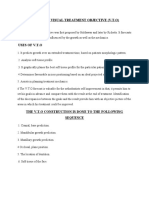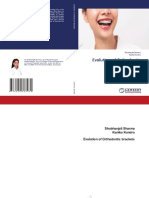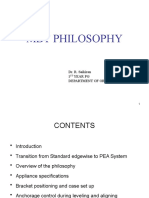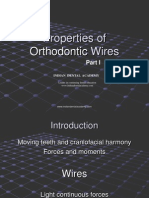60%(5)60% found this document useful (5 votes)
735 viewsMBT / Orthodontic Courses by Indian Dental Academy
MBT / Orthodontic Courses by Indian Dental Academy
Uploaded by
indian dental academyThe Indian Dental Academy is the Leader in continuing dental education , training dentists in all aspects of dentistry and offering a wide range of dental certified courses in different formats.
Indian dental academy provides dental crown & Bridge,rotary endodontics,fixed orthodontics,
Dental implants courses. For details pls visit www.indiandentalacademy.com ,or call
0091-9248678078
Copyright:
© All Rights Reserved
Available Formats
Download as PPT, PDF, TXT or read online from Scribd
MBT / Orthodontic Courses by Indian Dental Academy
MBT / Orthodontic Courses by Indian Dental Academy
Uploaded by
indian dental academy60%(5)60% found this document useful (5 votes)
735 views87 pagesThe Indian Dental Academy is the Leader in continuing dental education , training dentists in all aspects of dentistry and offering a wide range of dental certified courses in different formats.
Indian dental academy provides dental crown & Bridge,rotary endodontics,fixed orthodontics,
Dental implants courses. For details pls visit www.indiandentalacademy.com ,or call
0091-9248678078
Original Title
mbt / orthodontic courses by Indian dental academy
Copyright
© © All Rights Reserved
Available Formats
PPT, PDF, TXT or read online from Scribd
Share this document
Did you find this document useful?
Is this content inappropriate?
The Indian Dental Academy is the Leader in continuing dental education , training dentists in all aspects of dentistry and offering a wide range of dental certified courses in different formats.
Indian dental academy provides dental crown & Bridge,rotary endodontics,fixed orthodontics,
Dental implants courses. For details pls visit www.indiandentalacademy.com ,or call
0091-9248678078
Copyright:
© All Rights Reserved
Available Formats
Download as PPT, PDF, TXT or read online from Scribd
Download as ppt, pdf, or txt
60%(5)60% found this document useful (5 votes)
735 views87 pagesMBT / Orthodontic Courses by Indian Dental Academy
MBT / Orthodontic Courses by Indian Dental Academy
Uploaded by
indian dental academyThe Indian Dental Academy is the Leader in continuing dental education , training dentists in all aspects of dentistry and offering a wide range of dental certified courses in different formats.
Indian dental academy provides dental crown & Bridge,rotary endodontics,fixed orthodontics,
Dental implants courses. For details pls visit www.indiandentalacademy.com ,or call
0091-9248678078
Copyright:
© All Rights Reserved
Available Formats
Download as PPT, PDF, TXT or read online from Scribd
Download as ppt, pdf, or txt
You are on page 1of 87
INDIAN DENTAL ACADEMY
Leader in continuing dental education
www.indiandentalacademy.com
www.indiandentalacademy.com
The MBT Bracket System
The MBT bracket system is based on a
more balanced mix of science,tradition and
experience.
It is a bracket system for use with light
continuous forces, lacebacks and bendbacks
It is designed ideally to work with sliding
mechanics.
www.indiandentalacademy.com
Requirements for Providing
Quality Orthodontic Care
Good diagnosis and treatment planning.
Best available bracket system.
Correct positioning and repositioning of
brackets.
Clear philosophy on arch form.
Effective aligning technique.
www.indiandentalacademy.com
Ability to level the dental arches and control
overbite.
Correction of Class II and Class III
discrepancies .
Controlled space closure, with sliding
mechanics.
Persistence in finishing.
Good retention protocol.
www.indiandentalacademy.com
Diagnosis and treatment planning
-The Dental VTO
DENTAL VTO provides organized and simplified
information about direction and amount of dental
movement in U\L arches.
The information includes,the initial position and
desired movement of first molars ,the cuspids and
the dental midlines.
It is helpful in extraction and non-extraction decision
and can be referred during regular follow-up.
www.indiandentalacademy.com
Midline Molars
Right
Left
INITIAL MIDLINE AND MOLAR
POSITION
Chart 1
www.indiandentalacademy.com
Right Left
3x3
6x6
Crowding
Protrusion
Curve of Spee
Midline
3x3
Total
6x6
LOWER ARCH DISCREPANCY
Chart 2
www.indiandentalacademy.com
Secondary factors to provide
additional space.
Interproximal enamel reduction.
Uprighting or distal movement of lower first
molars.
Buccal uprighting of lower canines and
lower posterior teeth.
Leeway space or Espace.
www.indiandentalacademy.com
Midline
Cuspids
1
st
Molars
Right
Left
ANTICIPATED TREATMENT
CHANGE
Chart-3
www.indiandentalacademy.com
Case - 1
12 year old male patient.
Class II skeletal pattern.
High angle with increased lower facial height
4mm Class II on right side.
3.5mm Class II on left side.
Lower midline deviated 1mm to right.
4mm lower incisor crowding.
2mm Curve of Spee.
Lower anteriors 6mm in front of A.pog line.
www.indiandentalacademy.com
Right
4mm
Left
3.5mm
INITIAL MIDLINE AND MOLAR
POSITION
1mm
Chart-1
www.indiandentalacademy.com
Right Left
3x3
6x6
Crowding
Protrusion
Curve of Spee
Midline
3x3
Total
6x6
LOWER ARCH DISCREPANCY
Chart 2
-3
-3
-1
-1
-2 -2
-1 -1
+1 -1
-5 -5
-5
-5
www.indiandentalacademy.com
Right
Left
ANTICIPATED TREATMENT
CHANGE
(7)
(7)
2mm
5mm
1mm 5mm 2mm
2mm 9mm
0
1.5mm 8.5mm
(7)
(7)
Chart-3.
www.indiandentalacademy.com
Bracket Specification
THE FIRST GENERATION PAE
The original SWA was introduced by Andrews in
1972 and it had the features of Siamese edgewise
bracket.
He recommended a wide range of brackets.
- For extraction cases, anti-tip,anti-rotation, and
power arms for control space closure.
-Three sets of incisor brackets with varying
degrees of torque for different clinical situation.
www.indiandentalacademy.com
THE SECOND GENERATION PEA
To avoid inventory difficulties or multiple
bracket system, ROTH recommended a
single appliance system to manage both
extraction and non-extraction cases.
The appliance prescriptions developed by
Andrews and Roth were based on the
treatment mechanics used in their practice.
www.indiandentalacademy.com
THE THIRD GENERATION PEA
The MBT has been developed from the combined
clinical experience of the authors for more than 70
years.
It also introduced additional research input from
Japanese sources to update the scientific input.
It is designed ideally to work with sliding
mechanics,with light continuous forces, lacebacks
and bendbacks.
www.indiandentalacademy.com
The MBT Versatile Appliance
System.
Victory Series Brackets.
Clarity Brackets.
Unitek Full-Sized Twin
Brackets.
Molar bands,molar
bonding bases,and buccal
tubes.
www.indiandentalacademy.com
Design features of a modern
bracket system
Range of brackets
- Standard size metal brackets.
- Mid-size metal brackets.
-Esthetic brackets.
I mproved i.d system
Laser numbering of standard size metal
brackets.
Rhomboidal shape
Reduces bulk and assists accuracy of bracket
placement.
www.indiandentalacademy.com
Torque in base-the CAD factor
Using CAD it is possible to program the
computer to create the correct relationship
between the mid-point on the tooth and the slot
base,as with traditional torque-in-base.
Refinement of bracket base design
It is incorporated to increase strength and help
plaque control in difficult areas.
www.indiandentalacademy.com
Drawing of original
SWA bracket.
Dots (upper) and
dashes (lower) were
used for i.d purposes.
www.indiandentalacademy.com
Drawing of MBT
brackets.
Standard size
brackets have a
rhomboidal form
and numerical
i.d.system.
www.indiandentalacademy.com
Lower premolar
bracket may be
offset on specially
designed bases,to
increase bond
strength and reduce
the risk of bond
failure.
www.indiandentalacademy.com
Tapered bracket
bases on lower
incisors can help
in plaque control
in this difficult
area.
www.indiandentalacademy.com
Tip specification
ANTERIOR TIP
Reduced anterior tip was incorporated
into the appliance to conform to Andrews
original research,and to dramatically reduce
the anchorage needs of each case.
www.indiandentalacademy.com
I ncisor Tip
Cuspid Tip
Upper
Central
Upper
Lateral
Lower
Central
Lower
Lateral
Upper
Lower
MBT
Versatile+
4.0
8.0
0
0
8.0
3.0
Original
SWA
3
5.0
9.0
2.0
2.0
11.0
5.0
www.indiandentalacademy.com
UPPER POSTERIOR TIP
Upper bicuspid brackets are provided with
0
0
tip to keep these teeth in a more upright
position .
Upper molar brackets are provided with
0
0
tip, which when placed parallel to the
occlusal plane,introduces 5
0
tip into the
upper molars.
www.indiandentalacademy.com
Bicuspid Tip
Molar Tip
Upper First
Upper
Second
Upper First
Upper
Second
MBT Versatile+
0
0
0
0
Original SWA
2.0
2.0
5.0
5.0
www.indiandentalacademy.com
Upper tip considerations
The authors prefer a 0
0
tip bracket,with
the band seated parallel to the buccal
cusps.This gives 5
0
tip.
If a 5
0
bracket is used,the band must be
seated more gingivally at the mesial.
If a 5
0
bracket is used,and the band is
seated parallel to the buccal cusps,this
will result in an effective 10
0
tip on the
molar.
www.indiandentalacademy.com
LOWER POSTERIOR TIP
Lower posterior tip in the first and second
bicuspid brackets is maintained at 2
0
, to
slightly incline these teeth forward.
For the lower first and second molars,
0
0
tipped brackets are provided, which
when placed parallel to the occlusal
plane,introduces 2
0
of tip to these teeth.
www.indiandentalacademy.com
Lower Bicuspid Tip
Lower Molar Tip
Lower First
Lower
Second
Lower First
Lower
Second
MBT Versatile+
2.0
2.0
0
0
Original SWA
2.0
2.0
2.0
2.0
www.indiandentalacademy.com
Torque specification
INCISOR TORQUE
Upper incisor brackets are provided with
additional palatal root torque;while lower
incisor brackets are provided with additional
labial root torque.
This adjustment aids in the correction of the
most common torque problems occurring in
the incisor areas.
www.indiandentalacademy.com
Upper central incisor torque
Increased palatal
root torque for
upper centrals.
www.indiandentalacademy.com
Upper lateral incisor torque
Increased
palatal root
torque for
upper lateral
incisors.
www.indiandentalacademy.com
Lower incisor torque
Increased
labial root
torque for
lower
incisors.
www.indiandentalacademy.com
I ncisor Torque
I ncisor Torque
Upper Central
Upper
Lateral
Lower
Central
Lower
Lateral
MBT Versatile+
17.0
10.0
-6.0
-6.0
Original SWA
7.0
3.0
-1.0
-1.0
www.indiandentalacademy.com
Upper Cuspid ,bicuspid and
molar torque.
Upper cuspid and bicuspid brackets are
provided with the normal -7
0
of torque.
Upper molar brackets are provided with an
additional 5
0
of buccal root torque (-9
0
to -14
0
)
to reduce palatal cusp interferences with these
teeth.
www.indiandentalacademy.com
Upper canine torque.
Available in 7
0
,0
0
,
+7
0
, torque.
The 0
0
and +7
0
options
are for cases with
narrow maxillary bone
form and\or prominent
canine roots,and are
often used with
archwires in the tapered
form.
www.indiandentalacademy.com
Upper torque considerations
There was a tendency for
upper first molar palatal
cusps to extrude.
A bracket with 14
0
of
buccal torque gives extra
control.
In some cases it is necessary to
add buccal root torque to the
upper archwire ,even when
using a 14
0
torque bracket.
www.indiandentalacademy.com
Upper Cuspid, Bicuspid and Molar Torque
Upper
Cuspids
Upper 1
st
Bicuspids
Upper 2
nd
Bicuspids
Upper 1
st
Molars
Upper 2
nd
Molars
MBT
Versatile+
-7.0
-7.0
-7.0
-14.0
-14.0
Original
SWA
-7.0
-7.0
-7.0
-9.0
-9.0
www.indiandentalacademy.com
Lower cuspid,bicuspid and
molar torque.
Progressive buccal crown torque is
provided in the brackets of the lower
posterior segments.
This allows for buccal uprighting of these
teeth,which is beneficial in most cases.
www.indiandentalacademy.com
Lower canine
torque available in
6
0
,0
0
,+6
0
,
The 0
0
and +6
0
options are for
cases with narrow
mandibular bone
form or prominent
canine roots,or
deep bites at start of
treatment.
www.indiandentalacademy.com
Lower Cuspid, Bicuspid and Molar Torque
Lower
Cuspids
Lower 1
st
Bicuspids
Lower 2
nd
Bicuspids
Lower 1
st
Molars
Lower 2
nd
Molars
MBT
Versatile+
-6.0
-12.0
-17.0
-20.0
-10.0
Original
SWA
-11.0
-17.0
-22.0
-30.0
-35.0
www.indiandentalacademy.com
I n-out specification
It is 100% fully expressed.
In upper premolars an alternative bracket
which is 0.5mm thicker than normal,is used.
This is helpful in obtaining good alignment
of marginal ridges in cases with small upper
second premolars.
www.indiandentalacademy.com
I n-out modifications.
An upper second
bicuspid bracket with an
additional 0.5mm of
in-out compensation is
provided for the
common situation in
which upper second
bicuspids are smaller
than upper first
bicuspids.
www.indiandentalacademy.com
Horizontal bracket placement
errors
If brackets are placed
to the mesial or distal
of the vertical long
axis of the clinical
crown,improper tooth
rotation can occur.
www.indiandentalacademy.com
Axial or paralleling bracket
placement errors
These will occur if the
bracket wings do not
straddle the vertical
long axis of the crown
in a parallel manner.
Such errors lead to
improper crown tip.
www.indiandentalacademy.com
Thickness errors.
Excess bonding agent
beneath the bracket
base can cause
thickness and
rotational errors.
Can be eliminated by
pressing the bracket
against the tooth.
www.indiandentalacademy.com
Vertical errors
Vertical errors in
bracket placement are
caused by placing
brackets gingival or
incisal\occlusal to the
center of the clinical
crown.
www.indiandentalacademy.com
Gingival Concern.
Partially erupted tooth.
It is difficult to visualize
the center of the clinical
crown on partially
erupted teeth,when
treating young patients.
www.indiandentalacademy.com
Gingival I nflammation
Top:Healthy gingivae.
Bottom :The same case
with inflamed gingivae in
the upper right quadrant.
Gingival inflammation causes foreshortening,effectively
reducing the length of the clinical crowns.
www.indiandentalacademy.com
Teeth with palatally or lingually
displaced roots.
Individual teeth with
lingually displaced
roots can produce
short clinical crowns.
www.indiandentalacademy.com
Teeth with facially displaced
roots.
Individual teeth with
facially displaced
roots can produce long
clinical crowns.
www.indiandentalacademy.com
I ncisal or Occlusal concerns.
Incisal crown
fractures or
tooth wear make
it difficult to
visualize the
center of the
clinical crown.
www.indiandentalacademy.com
Crowns with long tapered
buccal cusps
Cuspids with
tapered clinical
crowns often do not
have adequate
contact with the
opposing teeth.
www.indiandentalacademy.com
Axial/paralleling variation
The tip position of the lateral
incisor brackets was varied to
help root paralleling.
In this case a lower incisor has been
extracted and root paralleling has
been helped by changing axial
positions of adjacent brackets.
www.indiandentalacademy.com
Palatally positioned lateral
incisors.
It is important to create adequate
space before attempting to move
palatally placed incisors.
It is beneficial to invert the
bracket on instanding lateral
incisors,giving 10
0
torque.
www.indiandentalacademy.com
Upper first molar bracket
positioning.
Correct position.
Band is seated more gingivally at
the mesial when treating Class II
molar relationship.
It is common error to allow the
band to seat too gingivally at
the distal,causing excessive
crown tip.
www.indiandentalacademy.com
Lower first molar bracket
positioning.
Correct band positioning.
A common error is to allow the
band to seat too gingivally at
the mesial .
www.indiandentalacademy.com
Lower first molar bracket
positioning
Occlusal interferences can be a
problem in some cases.
A lower second molar tube can be
used on lower first molars to avoid
interferences in some cases.
www.indiandentalacademy.com
Bracket Placement Gauge
www.indiandentalacademy.com
www.indiandentalacademy.com
www.indiandentalacademy.com
Arch form considerations for
stability and esthetics.
Bonwill and Hawley in 1905,suggested the
geometric method of constructing the ideal arch
form.
- The lower six anterior teeth lie along a circle
whose radius equaled their combined widths.
-From this circle an equilateral triangle is
created,the base of which represented the condylar
width.
-Premolars and molars should lie along these
extended lines.
www.indiandentalacademy.com
In 1907 Angle-
- The form of line from the premolars and
molars should resemble a parabolic curve.
-He proposed the need for natural curvature in
molar region.
In 1934 Chuck-
-Noted variation in arch form square, oval,
tapering.
-The premolar region should be wider than
canines to prevent excessive expansion of the
canines.
www.indiandentalacademy.com
In 1963 Boone
-Superimposed Bonwill-Hawley arch form on a
millimeter grid and used Angles method for construction.
-Thus Bonwill-Hawley arch form is used as a
template in edgewise.
Braun et al,1998
-Reported that the human arch form could be
represented by a complex mathematical formula,known as
the Beta function.
-This was calculated by entering measurements of
dental landmarks on orthodontic models into a computer
curve-fitting program.
www.indiandentalacademy.com
Traditional edgewise
wire bending and
Boone arch form.
www.indiandentalacademy.com
The Catenary curve is
formed by extending a
chain from two fixed
points.
Many of the tapered
arch forms provided
by orthodontic
manufactures today
are based on Catenary
curve.
www.indiandentalacademy.com
Brader Archform
www.indiandentalacademy.com
Relapse tendency after changing
arch form.
Riedel in 1969,postulated that arch form, in the
mandibular arch,cannot be permanently altered
during appliance therapy.
Similar research was done by Shapiro, Gardner,
Felton,De La Cruz and Burke suggesting that
changes in inter-molar width seem to be more
stable than those of inter-canine width.
www.indiandentalacademy.com
The four components of archform
i. ANTERIOR CURVATURE
Based on inter-canine width. Its shape
becomes more tapered when inter-canine width
is narrow and more square when inter-canine
width is wide.
ii. INTER-CANINE WIDTH
This appears to be the most critical aspect of
arch form,because significant relapse occurs if
this dimension is changed.
www.indiandentalacademy.com
POSTERIOR CURVATURE
In the posterior area a gradual curvature between
canine and second molars are preferred.
INTER-MOLAR WIDTH
Treatment changes in this dimension is more
stable.
Arch form in the inter-molar region can be
widened or narrowed,depending on the needs of
the case.
www.indiandentalacademy.com
MBT ARCH FORM
The three basic arch forms are tapered,
square and ovoid.
When superimposed they vary mainly in
inter-canine width,giving a range of
approximately 6mm.
Inter-molar widths are similar ,but the molar
areas can be widened or narrowed as
needed,by easy wire bending.
www.indiandentalacademy.com
THE TAPERED ARCH FORM
Indicated for patients with narrow ,tapered
arch form and gingival recession in canine
and premolar regions.
Cases undergoing single arch treatment,in
this way no expansion of treated arch
occurs.
www.indiandentalacademy.com
THE SQUARE ARCH FORM
Indicated in cases with broad arch form.
Cases that require buccal uprighting of the
lower posterior segments and expansion of
the upper arch.
After over-expansion has been achieved ,it
may be beneficial to change to the ovoid
arch form in the later stages of treatment.
www.indiandentalacademy.com
THE OVOID ARCH FORM
It is the most preferred arch form. The ovoid arch
form has proved to be good, reliable arch form for
high percentage of cases treated with PAE
Treated cases have shown good stability, with
minimal amounts of post-treatment relapse.
www.indiandentalacademy.com
ARCH FORMS - MBT
www.indiandentalacademy.com
Selection of Archform
i. Arch form template are placed on lower
study models.
-The inter-canine width is evaluated.
ii.If buccal uprighting is needed in the lower
arch, a wider arch form is selected.
www.indiandentalacademy.com
In 70% of cases buccal uprighting will result in
lower anterior relapse.
Cases in which buccal uprighting will be stable
include-
(a) Cases in which maxillary expansion is
indicated.
(b)Deep bite cases such as Class II /2 cases.
iii.Contour and width in the lower posterior
segment is estimated but this can be easily
customized.
www.indiandentalacademy.com
Arch wire Sequencing
EARLY IN TREATMENT -
.015/ .0175 multistranded /.014 SS
OR
.016 HANT. Less effect on arch form , so
ovoid arch form indicated for all cases.
MID TREATMENT
.014/.016/.018 SS
OR
.019x.025 Rec. HANT.
Influence arch form requires full inventory.
LATE TREATMENT-
.019x.025SS stocks of three arch forms.
www.indiandentalacademy.com
Archwire Coordination
It is important throughout treatment.
Most critical with heavier round wires and
.019x.025 SS.
Arch form templates can be used for coordination.
The upper wire should superimpose approximately
3mm outside lower wire.
This is representative of overlap of the upper teeth
relative to the lower teeth.
www.indiandentalacademy.com
SLIDING MECHANICS
Passive tiebacks.
Type 1 active tiebacks
www.indiandentalacademy.com
SLIDING MECHANICS
Type 2 active tieback.
Type 3 active tieback.
www.indiandentalacademy.com
ARCH WIRE WITH
SOLDERED HOOKS
www.indiandentalacademy.com
Arch form during finishing and
detailing
Phase of settling is preferred with lighter wires.
-Lower arch- .014SS or .016 NiTi
- Upper arch- .014SS sect.,with light
triangular elastics.
Teeth adjacent to extraction sites lightly tied
together.
An upper removable plate is required to maintain
maxillary expansion.
In Class II/1 cases to prevent overjet relapse, a full
.014SS arch wire with bendbacks is advocated.
www.indiandentalacademy.com
EXCLUSIVE MBT
APPLIANCE FEATURES.
Reduced anterior tip.
Upper bicuspid brackets with 0
0
tip.
Lower bicuspid brackets with 2
0
tip.
Additional palatal root torque for upper
incisors and additional labial root torque for
lower incisors.
Upper cuspid brackets with the normal
7
0
torque or 0
0
torque.
www.indiandentalacademy.com
Upper molar brackets with additional 5
0
buccal
root torque.
Progressive buccal crown torque in lower cuspids
and lower buccal segments.
Optional upper second bicuspid brackets with an
additional 0.5mm of in-out compensation.
Three bracket types,Clarity Aesthetic Brackets,
Victory Series brackets, and Unitek Full Size
Twin Brackets,all available with APC Adhesive
Coating.
www.indiandentalacademy.com
www.indiandentalacademy.com
For more details please visit
www.indiandentalacademy.com
You might also like
- Frankels ApplianceDocument33 pagesFrankels ApplianceMisha Aila MabulayNo ratings yet
- Andrews Six KeysDocument32 pagesAndrews Six KeysPARIJAT CHAKRABORTYNo ratings yet
- Self Ligating BracketsDocument94 pagesSelf Ligating BracketsGarimaa SurekaNo ratings yet
- JC On Quadrilateral AnalysisDocument43 pagesJC On Quadrilateral AnalysisANJU PRADHAN100% (2)
- Mds Orthodontics: Final Exam Question BankDocument39 pagesMds Orthodontics: Final Exam Question Bankdrzana78No ratings yet
- Rickett'S: Visual Treatment Objective (V.T.O)Document4 pagesRickett'S: Visual Treatment Objective (V.T.O)MariyamNo ratings yet
- Bioprogressive Therapy: DR Hiten KalraDocument100 pagesBioprogressive Therapy: DR Hiten Kalralingual course100% (1)
- Begg Mechanics1Document13 pagesBegg Mechanics1Mohammad Urooj AhmedNo ratings yet
- Deep BiteDocument22 pagesDeep BiteKanjiMasroor100% (1)
- The Andrews StrAight Wire Appliance PDFDocument198 pagesThe Andrews StrAight Wire Appliance PDFTati50% (2)
- RPD DesignDocument15 pagesRPD DesignRizky FebiyantiNo ratings yet
- Begg Mechanics1Document13 pagesBegg Mechanics1Mohammad Urooj AhmedNo ratings yet
- MBTDocument65 pagesMBTdangi.ishu29100% (2)
- Pre Adjusted Edgewise ApplianceDocument34 pagesPre Adjusted Edgewise ApplianceatikaNo ratings yet
- Refined BeggDocument18 pagesRefined BeggNeeraj Arora100% (2)
- Begg Technique ORTHO / Orthodontic Courses by Indian Dental AcademyDocument105 pagesBegg Technique ORTHO / Orthodontic Courses by Indian Dental Academyindian dental academy100% (1)
- Digital Planning and Custom Orthodontic TreatmentFrom EverandDigital Planning and Custom Orthodontic TreatmentK. Hero BreuningNo ratings yet
- Treatment Planning Single Maxillary Anterior Implants for DentistsFrom EverandTreatment Planning Single Maxillary Anterior Implants for DentistsNo ratings yet
- Surgical OrthodonticsDocument5 pagesSurgical OrthodonticsInternational Journal of Innovative Science and Research TechnologyNo ratings yet
- Pedagogy Torqunig AuxillariesDocument39 pagesPedagogy Torqunig AuxillariesGudiyA Kaur100% (1)
- TOMAC: An Orthognathic Treatment Planning System Part 1 Soft-Tissue AnalysisDocument89 pagesTOMAC: An Orthognathic Treatment Planning System Part 1 Soft-Tissue AnalysisDrKamran Momin100% (1)
- Braking MechanicsDocument55 pagesBraking MechanicsDyna AbhilashNo ratings yet
- Functional OcclusionDocument186 pagesFunctional OcclusionNam Bui100% (1)
- Utility ArchesDocument2 pagesUtility ArchesDevanand Gupta80% (5)
- Canine Impaction Final PDFDocument136 pagesCanine Impaction Final PDFDr. ShantanuNo ratings yet
- Vertical Skeletal DysplasiaDocument119 pagesVertical Skeletal DysplasiaAshish Mathew50% (2)
- Friction Mechanics in OrthodonticsDocument141 pagesFriction Mechanics in Orthodonticsprateek mathur100% (2)
- Growth Relativity HypothesisDocument39 pagesGrowth Relativity Hypothesisvelangni100% (1)
- Orthodontic Intrusion - An InsightDocument4 pagesOrthodontic Intrusion - An InsightThang Nguyen Tien100% (1)
- Speech and MalocclusionDocument36 pagesSpeech and MalocclusionDrNidhi Krishna100% (1)
- Treatment TimingDocument35 pagesTreatment Timingramya0% (2)
- Refinements in BEGGS TECHNIQUEDocument136 pagesRefinements in BEGGS TECHNIQUEaj100% (4)
- Refinements in Beggs TechniqueDocument136 pagesRefinements in Beggs TechniqueGokul SivaNo ratings yet
- ENVELOPE OF DISCREPANCY Seminar 13Document24 pagesENVELOPE OF DISCREPANCY Seminar 13Tannu ChhaparwalNo ratings yet
- Comparison of Skeletal and Dentoalveolar Effects of The Forsus and Advansync in Treatment of Class II MalocclusionsDocument67 pagesComparison of Skeletal and Dentoalveolar Effects of The Forsus and Advansync in Treatment of Class II MalocclusionsMilena Ramirez100% (1)
- Hard Tissue CephalometricsDocument170 pagesHard Tissue CephalometricsNisha Nair100% (1)
- Molar Distalization PDFDocument3 pagesMolar Distalization PDFdruzair00775% (4)
- Evolution of Orthodontic BracketsDocument281 pagesEvolution of Orthodontic Bracketssajida khan100% (2)
- Tweed CorrectionDocument5 pagesTweed Correctiondoctorneha66100% (1)
- Does The Eastman Correction Over-Or Under-Adjust ANB For Positional Changes of N?Document5 pagesDoes The Eastman Correction Over-Or Under-Adjust ANB For Positional Changes of N?Thendral DevanathanNo ratings yet
- Roth's Prescription / Orthodontic Courses by Indian Dental AcademyDocument64 pagesRoth's Prescription / Orthodontic Courses by Indian Dental Academyindian dental academy100% (1)
- Occlusal Cant (Autosaved)Document48 pagesOcclusal Cant (Autosaved)Gauri Khade100% (1)
- HeadgearsDocument78 pagesHeadgearsMohammed bilal50% (2)
- MBT Philosophy: Dr. R. Saikiran 1 Year PG Department of OrthodonticsDocument170 pagesMBT Philosophy: Dr. R. Saikiran 1 Year PG Department of Orthodonticsravali tankala67% (3)
- Edgewise AppDocument27 pagesEdgewise AppReshamIrshadNo ratings yet
- Banding in OrthodonticsDocument22 pagesBanding in OrthodonticsJessamine de Jesus0% (1)
- One Stage Vs Two StageDocument29 pagesOne Stage Vs Two StageAya Elsayed100% (1)
- The Butter y System: Brackets, Prescription, and AuxiliariesDocument9 pagesThe Butter y System: Brackets, Prescription, and AuxiliariesNonoNo ratings yet
- Point A Revisited PDFDocument5 pagesPoint A Revisited PDFRonak BanquetsNo ratings yet
- Role of Drugs in Orthodontics / Orthodontic Courses by Indian Dental AcademyDocument239 pagesRole of Drugs in Orthodontics / Orthodontic Courses by Indian Dental Academyindian dental academyNo ratings yet
- IBO - Information For CandidatesDocument10 pagesIBO - Information For Candidatesdrzana78No ratings yet
- Recycling in OrthodonticsDocument71 pagesRecycling in OrthodonticsReene Mary100% (1)
- Customized BracketsDocument69 pagesCustomized BracketssakshiNo ratings yet
- Beggs Mechanotherapy Ortho / Orthodontic Courses by Indian Dental AcademyDocument130 pagesBeggs Mechanotherapy Ortho / Orthodontic Courses by Indian Dental Academyindian dental academy100% (6)
- Understanding The Basis of Space Closure in OrthodonticsDocument26 pagesUnderstanding The Basis of Space Closure in Orthodonticsnunna cebong100% (2)
- Frictionless Mechanics in OrthodonticsDocument210 pagesFrictionless Mechanics in Orthodonticschaitree100% (1)
- 12 Diagnostic Aids For Functional AppliancesDocument240 pages12 Diagnostic Aids For Functional AppliancesDr Shivam VermaNo ratings yet
- V-Bend and Anchorage in Orthodontics: Mehak Arya Iyrmds Dept of OrthodonticsDocument37 pagesV-Bend and Anchorage in Orthodontics: Mehak Arya Iyrmds Dept of OrthodonticsMehak Arya100% (1)
- Balancing The Books On Orthodontic Treatment: An Integrated Analysis of ChangeDocument10 pagesBalancing The Books On Orthodontic Treatment: An Integrated Analysis of ChangeLikhitaNo ratings yet
- Ss Wire Properties / Orthodontic Courses by Indian Dental AcademyDocument79 pagesSs Wire Properties / Orthodontic Courses by Indian Dental Academyindian dental academyNo ratings yet
- The Roth Prescription / Orthodontic Courses by Indian Dental AcademyDocument85 pagesThe Roth Prescription / Orthodontic Courses by Indian Dental Academyindian dental academy100% (3)
- Study Model / Orthodontic Courses by Indian Dental AcademyDocument134 pagesStudy Model / Orthodontic Courses by Indian Dental Academyindian dental academy83% (6)
- Space Closure3 / Orthodontic Courses by Indian Dental AcademyDocument51 pagesSpace Closure3 / Orthodontic Courses by Indian Dental Academyindian dental academy100% (5)
- Sterilization of Ortho Instruments / Orthodontic Courses by Indian Dental AcademyDocument57 pagesSterilization of Ortho Instruments / Orthodontic Courses by Indian Dental Academyindian dental academyNo ratings yet
- Saliva / Orthodontic Courses by Indian Dental AcademyDocument191 pagesSaliva / Orthodontic Courses by Indian Dental Academyindian dental academyNo ratings yet
- Root Movement in Orthodontics / Orthodontic Courses by Indian Dental AcademyDocument93 pagesRoot Movement in Orthodontics / Orthodontic Courses by Indian Dental Academyindian dental academy86% (7)
- Vit and Hormone in Relation To Growth and Development / Orthodontic Courses by Indian Dental AcademyDocument38 pagesVit and Hormone in Relation To Growth and Development / Orthodontic Courses by Indian Dental Academyindian dental academyNo ratings yet
- Soft Tissus Ceph Analysis / Orthodontic Courses by Indian Dental AcademyDocument155 pagesSoft Tissus Ceph Analysis / Orthodontic Courses by Indian Dental Academyindian dental academy100% (1)
- Roth's Prescription / Orthodontic Courses by Indian Dental AcademyDocument64 pagesRoth's Prescription / Orthodontic Courses by Indian Dental Academyindian dental academy100% (1)
- Radiology in Orthodontics-Dr - Kavitha / Orthodontic Courses by Indian Dental AcademyDocument85 pagesRadiology in Orthodontics-Dr - Kavitha / Orthodontic Courses by Indian Dental Academyindian dental academyNo ratings yet
- Role of Drugs in Orthodontics / Orthodontic Courses by Indian Dental AcademyDocument239 pagesRole of Drugs in Orthodontics / Orthodontic Courses by Indian Dental Academyindian dental academyNo ratings yet
- Pre-Natal and Post-Natal Development of Maxilla Part 2 / Orthodontic Courses by Indian Dental AcademyDocument72 pagesPre-Natal and Post-Natal Development of Maxilla Part 2 / Orthodontic Courses by Indian Dental Academyindian dental academyNo ratings yet
- Rapid Molar Intrusion Device / Orthodontic Courses by Indian Dental AcademyDocument55 pagesRapid Molar Intrusion Device / Orthodontic Courses by Indian Dental Academyindian dental academyNo ratings yet
- Pre-Natal and Post-Natal Development of Maxilla Part 4 / Orthodontic Courses by Indian Dental AcademyDocument76 pagesPre-Natal and Post-Natal Development of Maxilla Part 4 / Orthodontic Courses by Indian Dental Academyindian dental academyNo ratings yet
- Orthodontic Wires - Properties / Orthodontic Courses by Indian Dental AcademyDocument226 pagesOrthodontic Wires - Properties / Orthodontic Courses by Indian Dental Academyindian dental academy100% (1)
- Periodontal Changes in Ortho Treatment / Orthodontic Courses by Indian Dental AcademyDocument81 pagesPeriodontal Changes in Ortho Treatment / Orthodontic Courses by Indian Dental Academyindian dental academyNo ratings yet
- Orthodontic Brackets / Orthodontic Courses by Indian Dental AcademyDocument102 pagesOrthodontic Brackets / Orthodontic Courses by Indian Dental Academyindian dental academyNo ratings yet
- Lasers and Its Role in Endodontics / Orthodontic Courses by Indian Dental AcademyDocument73 pagesLasers and Its Role in Endodontics / Orthodontic Courses by Indian Dental Academyindian dental academyNo ratings yet
- Orthodontic Adhesives / Orthodontic Courses by Indian Dental AcademyDocument137 pagesOrthodontic Adhesives / Orthodontic Courses by Indian Dental Academyindian dental academy100% (1)
- MAA Final / Orthodontic Courses by Indian Dental AcademyDocument93 pagesMAA Final / Orthodontic Courses by Indian Dental Academyindian dental academyNo ratings yet
- Obstructive Sleep Apnea - Dr.M.M.varadharaja / Orthodontic Courses by Indian Dental AcademyDocument168 pagesObstructive Sleep Apnea - Dr.M.M.varadharaja / Orthodontic Courses by Indian Dental Academyindian dental academy100% (1)
- Molecular Basis PART 1 / Orthodontic Courses by Indian Dental AcademyDocument188 pagesMolecular Basis PART 1 / Orthodontic Courses by Indian Dental Academyindian dental academyNo ratings yet
- Methods of Gaining Space. / Orthodontic Courses by Indian Dental AcademyDocument70 pagesMethods of Gaining Space. / Orthodontic Courses by Indian Dental Academyindian dental academy100% (2)
- Interceptive Orthodontics 1 / Orthodontic Courses by Indian Dental AcademyDocument44 pagesInterceptive Orthodontics 1 / Orthodontic Courses by Indian Dental Academyindian dental academyNo ratings yet
- Mandibular Growth Rotation (2) / Orthodontic Courses by Indian Dental AcademyDocument28 pagesMandibular Growth Rotation (2) / Orthodontic Courses by Indian Dental Academyindian dental academyNo ratings yet
- Hybrid Functional Appliance / Orthodontic Courses by Indian Dental AcademyDocument127 pagesHybrid Functional Appliance / Orthodontic Courses by Indian Dental Academyindian dental academy100% (2)
- Materials in Orthodontics / Orthodontic Courses by Indian Dental AcademyDocument124 pagesMaterials in Orthodontics / Orthodontic Courses by Indian Dental Academyindian dental academy100% (2)
- Indices / Orthodontic Courses by Indian Dental AcademyDocument77 pagesIndices / Orthodontic Courses by Indian Dental Academyindian dental academyNo ratings yet
- Implants and Anchorage / Orthodontic Courses by Indian Dental AcademyDocument52 pagesImplants and Anchorage / Orthodontic Courses by Indian Dental Academyindian dental academy100% (1)
- Ferula de MichiganDocument11 pagesFerula de MichiganFernando Espada SalgadoNo ratings yet
- BIONATORDocument59 pagesBIONATORDhanusha Reddy67% (3)
- Orthodontic Treatment of Severe Crowding Malocclusion With Extraction of PremolarsDocument4 pagesOrthodontic Treatment of Severe Crowding Malocclusion With Extraction of Premolarsyuni madjidNo ratings yet
- Occlusion in Fpd-13.08.10Document104 pagesOcclusion in Fpd-13.08.10Paridhi Garg100% (1)
- Oral Anatomy Q&ADocument8 pagesOral Anatomy Q&AHanny CarinoNo ratings yet
- Ormco CatalogoDocument211 pagesOrmco CatalogoVincent Walsh100% (1)
- Transpositions: C H A P T e RDocument8 pagesTranspositions: C H A P T e Rjohnmax100% (2)
- Oral Disorders of Exotic Ungulates: Felicia Knightly, DVM, Peter Emily, DDS, AVDCDocument6 pagesOral Disorders of Exotic Ungulates: Felicia Knightly, DVM, Peter Emily, DDS, AVDCLeo AriasNo ratings yet
- Distinguishing Between Human and Non-Human BonesDocument70 pagesDistinguishing Between Human and Non-Human BonespoovenmoonoosamyNo ratings yet
- Occlusion As Reked To Co Prosthodontics Refrtow E: Complete DenturesDocument11 pagesOcclusion As Reked To Co Prosthodontics Refrtow E: Complete DenturesKrupali JainNo ratings yet
- Orthodontics and Pediatric DentistryDocument62 pagesOrthodontics and Pediatric DentistryAnggaHumalaBeltsazarNapitupuluNo ratings yet
- Lec9 - Intra Oral Radiographic TechniquesDocument13 pagesLec9 - Intra Oral Radiographic TechniquesSawsan Z. JwaiedNo ratings yet
- Geometric Analysis of The Mandibular First Premolar and Correlation With Its Functions Using Finite Element MethodDocument10 pagesGeometric Analysis of The Mandibular First Premolar and Correlation With Its Functions Using Finite Element MethodIJAR JOURNALNo ratings yet
- Canines Maxillary and MandibularDocument4 pagesCanines Maxillary and MandibularLamya ZamanNo ratings yet
- Removable Orthodontic Appliances: New Perspectives On Capabilities and EfficiencyDocument6 pagesRemovable Orthodontic Appliances: New Perspectives On Capabilities and EfficiencyYosu Obok HermanlieNo ratings yet
- MGBM System, New Protocol For Class II Non Extraction Treatment Without CooperationDocument14 pagesMGBM System, New Protocol For Class II Non Extraction Treatment Without CooperationJose CollazosNo ratings yet
- Development of Ooclusion 2Document17 pagesDevelopment of Ooclusion 2Richa AhlawatNo ratings yet
- 7JC - Early TreatmentDocument18 pages7JC - Early Treatmentanon_137544084No ratings yet
- Smile DesignDocument64 pagesSmile Designbaskarend67% (6)
- An Innovative Use of the K-SIR ArchDocument4 pagesAn Innovative Use of the K-SIR ArchSadhu AbhijeetNo ratings yet
- Adts Guidelines For Access CavityDocument7 pagesAdts Guidelines For Access Cavityrojek63No ratings yet
- International Dental and Medical Journal of Advanced ResearchDocument5 pagesInternational Dental and Medical Journal of Advanced ResearchShirmayne TangNo ratings yet
- Finishing The OcclusionDocument36 pagesFinishing The OcclusionParameswaran ManiNo ratings yet
- 013Document14 pages013Lima JúniorNo ratings yet
- Influence of Radiographic Position of Ectopic Canines On The Duration of Orthodontic TreatmentDocument5 pagesInfluence of Radiographic Position of Ectopic Canines On The Duration of Orthodontic TreatmentMohammed FeroNo ratings yet
- Mixed Dentition Analysis / Orthodontic Courses by Indian Dental AcademyDocument14 pagesMixed Dentition Analysis / Orthodontic Courses by Indian Dental Academyindian dental academy100% (1)
- Unitek: Zerobase OrthodonticsDocument8 pagesUnitek: Zerobase OrthodonticsKanchit SuwanswadNo ratings yet
- Posterior and Anterior Components of Force During Bite LoadingDocument8 pagesPosterior and Anterior Components of Force During Bite LoadingDr. Zardasht N. BradostyNo ratings yet




















































































































